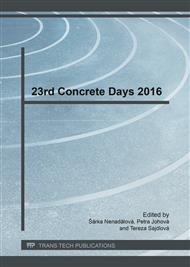p.227
p.232
p.238
p.244
p.249
p.255
p.263
p.269
p.275
Moment-Rotation Response of Beam-Column Connections in Precast Concrete Structures
Abstract:
This paper provides an experimental investigation on the moment-rotation response of typical moment resisting beam-column connections, employing continuous negative bars consolidated with cast in place concrete over the precast beam and passing through grouted corrugated sleeves into an intermediate column. According to [1], the relative beam-column rotation is highly dependent on the elongation mechanism of the negative bars related to both the embedment length into the grouted sleeves and the development length over the beam end, being also inversely dependent on the vertical distance between the position of the top bars and the centre of rotation at end beam section. The flexural secant stiffness of the moment-rotation response is caused by a sum of the joint opening mechanisms at the beam-column interface and crack propagation within the connection zone, wherein the bond-slip at crack positions occurs prior to the first yielding of the negative bars. Therefore, the semi-rigid behaviour of the beam-column connections is associated with deformation mechanisms that occur at the SLS, but which also affects the global behaviour and stability analysis of precast frames at the ULS.Cruciform tests of full scale beam-column connections were carried out at the Precast Research Centre of the Federal University of Sao Carlos (Brazil), where 6 prototypes were studied varying the detailing of the positive connectors over the concrete corbel. The first pair of connectors employed elastomeric bearing pads with 2 vertical dowel bars, the second pair of connectors employed horizontal joints filled with grout with 2 vertical dowel bars and the last pair of connectors employed positive welded plates. The comparison between the experimental results showed that the smallest secant stiffness, which was obtained from the connector with elastomeric bearing pad, was corresponded to 89% and to 82% of the highest secant stiffness obtained for the connectors with welded plates and grouted joint, respectively. Therefore, the experimental results indicate that the major deformation mechanism within the beam-column connections is mostly dependent on the elongation of the top bars. Finally, a simplified analytical equation has been calibrated against the experimental results of the studied beam-column connections.
Info:
Periodical:
Pages:
269-274
Citation:
Online since:
May 2017
Price:
Сopyright:
© 2017 Trans Tech Publications Ltd. All Rights Reserved
Share:
Citation:


